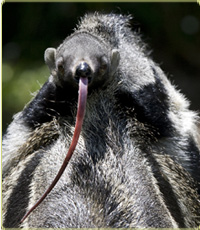About Amazonia
The Amazon River stretches more than 4,000 miles. The tropical rainforest of its watershed is home to millions of species of plants and animals, making it the planet's most diverse ecosystem.
The Zoo is home to an Amazonia Exhibit and animals from Amazonia, as well as many animals from other parts of South America.
Rainforest Exhibit Closed
The second floor of the Amazonia Exhibit is temporarily closed due to maintenance. We hope to reopen it in July and will update this space when it's open again.
Spectacled Bear Update
 Two of the Zoo's spectacled bears have been busy lately. Male Nikki and female Billie Jean mated. If she is pregnant, she'd give birth late this year. Also, Billie Jean built an authentic nest in a tree, very rare behavior for a zoo bear.
Two of the Zoo's spectacled bears have been busy lately. Male Nikki and female Billie Jean mated. If she is pregnant, she'd give birth late this year. Also, Billie Jean built an authentic nest in a tree, very rare behavior for a zoo bear. ![]() Find out more.
Find out more.
The only bear native to South America, spectacled bears (sometimes called Andean bears) live in the Andes range and outlying mountain ranges, from western Venezuela south to Bolivia. Each individual spectacled bear has it own distinctive set or “fingerprint” of distinct cream or whitish markings on its head, throat and chest. ![]() Learn more.
Learn more.
Baby Giant Anteater Explores More
 Cyrano, the Zoo's young male giant anteater, is now three months old and weighs close to 17 pounds. He has been spending plenty of time on the ground and getting lots of exercise. He isn’t very good at dismounting from his mother's back yet and usually waits for her to lie down to get off.
Cyrano, the Zoo's young male giant anteater, is now three months old and weighs close to 17 pounds. He has been spending plenty of time on the ground and getting lots of exercise. He isn’t very good at dismounting from his mother's back yet and usually waits for her to lie down to get off.
![]() Read more in the latest keeper update.
Read more in the latest keeper update.
This is only the second anteater to be born here in the Zoo's 120-year history.
Visit the Anteaters
You can see the anteaters in their yard next to Lemur Island when the weather is nice. The schedule may vary but the keepers will likely put Maripi, the mother, and Cyrano outside in the morning, and Dante, the father, is out in the afternoon. Giant anteater fathers play no part in the rearing of offspring.
Giant anteater habitat spans most of Latin America—from Belize to Argentina. Anteaters use their keen sense of smell to detect termite mounds and anthills and tear them open with strong claws to suck up insects through their elongated jaws. Anteaters also have sticky tongues that can extend up to two feet long and help collect insects—they can eat up to 30,000 ants a day!
![]() Learn more.
Learn more.
Celebrate the birth! ![]() Adopt a giant anteater.
Adopt a giant anteater.
Amazonia Exhibit
The Zoo's Amazonia Exhibit leads visitors into the realm of the Amazon River Basin, where
giant arapaima, pacu, red-tailed catfish, and piranhas swim
in shallow water, and poison arrow frogs, titi monkeys, tanagers, and a two-toed sloth inhabit the world above.
Living kapok, avocado, and cocoa trees spread their roots
in this enclosed tropical habitat. ![]() Take an audio tour of the exhibit.
Take an audio tour of the exhibit.
Adjacent to the exhibit, the Amazonia Science Gallery offers a glimpse into the scientific research Zoo staff conduct in the lab and in the field.
|
Can’t see any animals?
Watching Amazon river fishes:
Here is a glimpse into the rich and vibrant underwater life of the Amazon. When the large, serpent-like arapaimas swim past the camera, you will get a close-up look at one of the largest freshwater fish in the world. The ones you can see here range from five to six feet in length, but may reach up to ten feet and weigh 300 pounds. Red-tailed catfish, black pacus, and other fish share this 27,000-gallon aquarium below a living tropical forest.
|
Tropical Wildlife at the Zoo
Elsewhere in the Zoo are golden lion tamarins, native to Brazilian tropical forest, which have been saved from extinction by Zoo conservationists. ![]() Golden Lion Tamarin Program
Golden Lion Tamarin Program
Leaf-cutter ants, Cuban crocodiles, and two species of bats hail from tropical and subtropical forests in the Americas. And, many of our familiar North American breeding birds spend the winter in these forests. ![]() Migratory Bird Center
Migratory Bird Center
Beyond Amazonia
Tropical forest also covers parts of Central and West Africa, home to western lowland gorillas and pygmy hippos, and the site of a major biodiversity study in Gabon, and Madagascar, home to lemurs.
In Asia,
elephants, tigers, clouded leopards, orangutans, gibbons,
Eld's deer, gharial, and many other Zoo species live
in tropical forests. ![]() Asia
Trail
Asia
Trail
Sometimes people are surprised to learn that rainforest does not blanket all of South America. Large expanses of this continent are grasslands, home to capybara, maned wolves, maras, and seriemas, among other species found at the Zoo.




